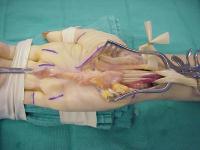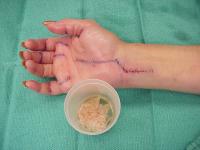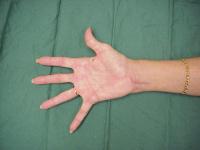Flexor synovectomy may be indicated
for infectious, rheumatic, or nonspecific proliferative tenosynovitis.
It requires meticulous and extensive dissection. There are a variety of
surgical exposure techniques, which should be planned in an extensile fashion.
This case demonstrates an exposure technique intended to minimize the extent
of fillet, while allowing adequate access to the flexor tendons from forearm
through all fingers.
The patient had ring finger flexor tendinitis operated
on elsewhere, and at surgery was found to have an unusual degree of local
synovial reaction. She had a complete synovectomy of the ring finger, and
pathology report was inconclusive. Rheumatologic evaluation was normal.
Several years later, she presented with anterior wrist fullness, with swelling,
triggering and stiffness of all remaining digits. She had no carpal tunnel
symptoms. |






